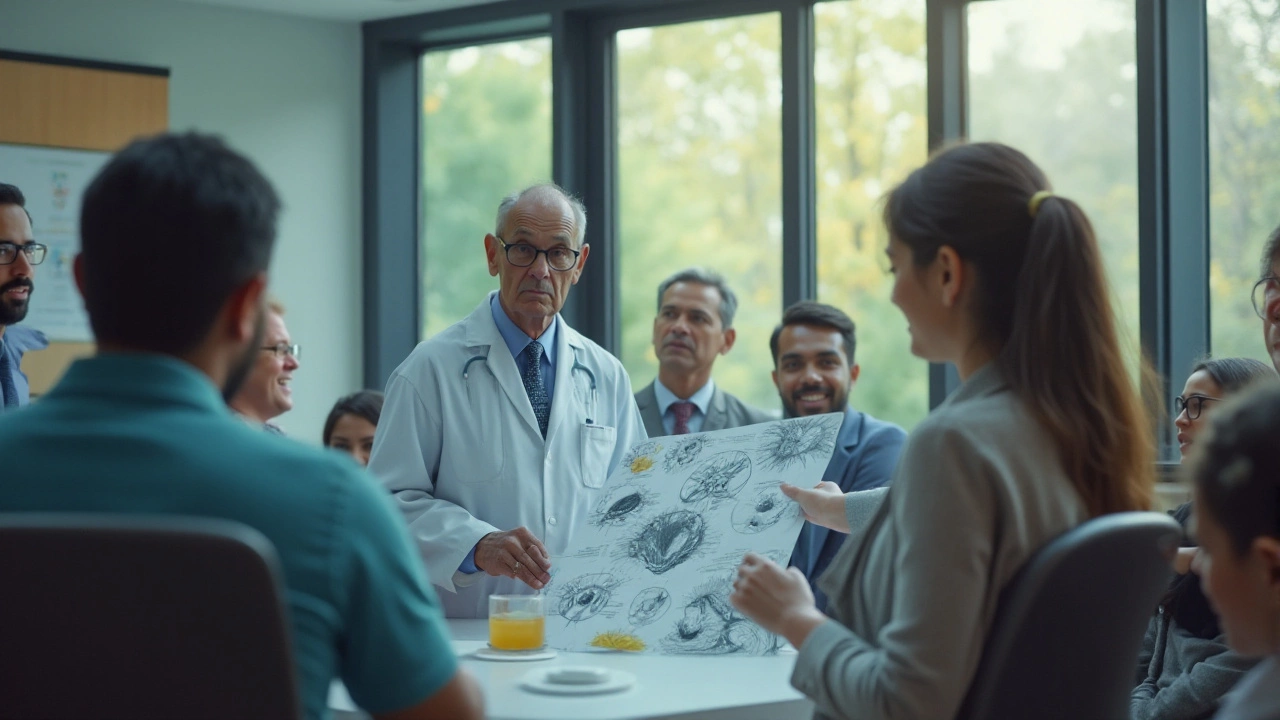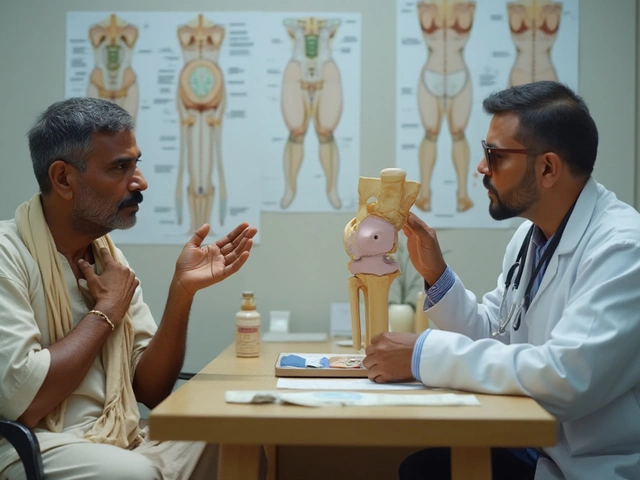Cancer is a formidable adversary, and while hope remains a crucial part of any battle, understanding the realities of certain diagnoses can prepare us for the challenges ahead. Survival rates can vary significantly across different cancer types due to factors like early detection, location, and advancements in treatment options.
This article delves into those cancers typically associated with lower survival rates, providing insights into why these figures are daunting and what the medical community is doing to improve them. By exploring the characteristics and treatment of these aggressive cancers, we aim to shed light on paths to enhance patient care and inspire ongoing research efforts.
- Introduction to Cancer Survival Rates
- Pancreatic Cancer
- Liver Cancer
- Lung Cancer
- Cancer Survival and Treatment Advances
- Support and Resources for Patients
Introduction to Cancer Survival Rates
When it comes to understanding cancer, one of the most crucial aspects people encounter is the concept of survival rates. These rates provide a statistical glimpse into the prognosis of cancer patients, based on large groups of people. Unlike personal horoscopes in newspapers, they aren't predictive, but they help doctors, patients, and their families grapple with expectations. Often, survival rates are represented as percentages of people who survive for a designated number of years—commonly five years—after their cancer diagnosis. The information draws from substantial studies and reflects averages that can sometimes be misrepresentative of individual cases, yet they offer a benchmark of hope or challenge.
The five-year survival rate is a particularly important metric. It's a measure that considers the proportion of patients alive five years after diagnosis. It transcends just the peak of the treatment journey, encompassing the initial battle, the periods of worry and hope, and for some, the places of solace or despair when considering potential relapse. This rate allows us to gauge how different cancer types might become aggressive and the effectiveness of new treatments over time. However, it’s essential to consider survival rates alongside other factors such as lifestyle, patient age, and overall health. These elements significantly influence individual survival chances and must be part of any meaningful conversation about cancer prognosis.
Understanding Variability in Cancer Types
Not all cancers hold the same grim facts when it comes to survival rates. Some forms, like certain skin cancers if detected early, have excellent outcomes. However, others such as pancreatic and liver cancers often do not present symptoms until they have progressed to advanced stages, leading to the sobering numbers seen in survival rate statistics. This speaks to the need for improved screening and early detection efforts, as well as innovative treatment approaches that can combat these challenging types of cancer where they attack fiercest. According to a report by the American Cancer Society, "Early detection can significantly improve prognosis and treatment success," reinforcing how critical timing is in the world of oncology.Considering survival rates is not just about attracting attention to statistics, but it’s about celebrating improvements and recognizing areas that demand urgent research. Studies consistently show that with breakthroughs in technology and medicine, such as precision medicine and immunotherapy, survival rates are incrementally improving. Tools like these harness the body's own defenses with greater acuity against tumors, uncovering pathways to longer, more fulfilling lives for patients. Yet it remains a sobering reminder of the work that continues to require passion, hope, and tireless commitment in finding better solutions.
Pancreatic Cancer
Pancreatic cancer is often referred to as a silent killer because its symptoms typically emerge only in the later stages when treatment options become limited and complex. The pancreas, tucked away loWs in the abdomen behind the stomach, plays a critical role in digestion and hormone regulation, making its good health essential for overall well-being. Unfortunately, the cancer tends to grow quickly and often spreads to nearby organs before it is detected, contributing to its low survival rates.
Most individuals diagnosed with pancreatic cancer report symptoms such as jaundice, unexplained weight loss, abdominal pain, and changes in stool. But by the time these symptoms become evident, it's often too late for surgical options that might effectively treat the cancer. As a result, the survival rate remains one of the lowest among common cancers. In fact, statistics often point to a five-year relative survival rate under 10% according to the American Cancer Society. This stark statistic underscores the aggressive nature of the disease and the urgency in finding new treatment modalities.
Currently, the preferred treatments for pancreatic cancer include surgery, radiation therapy, and chemotherapy. These therapies are chosen based on how far the cancer has progressed, where it's located, and a patient's overall health profile. Surgery is mainly viable if the cancer hasn't spread beyond the pancreas, but such cases are rare because the disease often remains asymptomatic until metastasis. Chemotherapy and radiation might help prolong life or alleviate symptoms, but they often come with side effects that can impact a patient's quality of life. Cancer treatment innovations such as immunotherapy and targeted therapy have also been introduced, but their efficacy in treating pancreatic cancer is still being evaluated in clinical trials.
"Pancreatic cancer is notoriously difficult to treat because most cases do not present symptoms until the late stages," says Dr. Laura Smith, a leading oncologist at Massachusetts General Hospital. "Early detection is critical, but the real game-changer will come with more effective, targeted therapies."
With research intensifying, there is hope on the horizon. Scientists are exploring novel techniques such as personalized medicine, which tailors treatment to a patient's genetic profile, potentially improving outcomes. Early detection screenings are also being refined, aiming at diagnosing individuals at a stage where surgical procedures could be more beneficial. Least survivable cancers like pancreatic cancer have drawn attention to the need for robust screening programs that can catch the disease before it reaches an advanced stage.
The public's awareness and education about the risks of pancreatic cancer, including genetic factors and lifestyle choices, are vital. Data indicate that smoking and obesity significantly increase risks which is why healthy lifestyle choices are often stressed alongside regular check-ups if there's a family history of the illness. Healthy living can sometimes support the prevention of many types of cancer, although genetic predispositions still play a significant role in its development. It is this combination of awareness, prevention, and cutting-edge research that leaves room for optimism while remaining a challenging endeavor in cancer treatment.

Liver Cancer
Liver cancer, often synonymous with hepatocellular carcinoma (HCC), poses a significant threat due to its stealthy nature and typically late-stage diagnosis. Liver cancer is notorious for low survival rates, often linked to the symptoms' subtlety. It seldom presents noticeable signs during early stages, frequently advancing undetected until progression impairs liver functions. Among various cancers, it is one of the most challenging to diagnose early, contributing to its daunting prognosis. The global incidence of liver cancer has seen an alarming rise, particularly in regions with high prevalence of chronic hepatitis infections.
The risk factors for liver cancer are intricately tied to chronic liver disease. Conditions like hepatitis B and C, cirrhosis, and non-alcoholic fatty liver disease considerably heighten the risks. Moreover, lifestyle choices such as alcohol consumption and smoking also play a crucial role in elevating susceptibility. Statistics reflect that an estimated 70-90% of individuals with HCC have underlying cirrhosis. This strong association underscores the critical need for vigilant monitoring and management of liver health to mitigate cancer risk.
Modern treatment strategies offer several avenues for combatting liver cancer, though the journey is often arduous. Surgical resection, liver transplants, and local ablative therapies are options contingent on the cancer's stage and extent. Interestingly, advancements in medical research have introduced targeted therapies and immunotherapies, which provide new hope by specifically attacking cancer cells, minimizing damage to healthy tissues. As research progresses, combining traditional treatments with newer modalities like radiofrequency ablation and transarterial chemoembolization continues to enhance effectiveness.
According to the American Cancer Society, "while liver cancer is aggressive, early detection can significantly improve treatment outcomes and survival rates." This highlights the importance of regular screening and prompt attention to liver health, especially for individuals at high risk due to pre-existing liver conditions.
Preventive measures are pivotal in altering the trajectory of liver cancer incidence. Vaccination against hepatitis B has proven vital in reducing the risk, particularly in endemic areas. Additionally, monitoring alcohol intake, maintaining a healthy weight, and managing metabolic diseases like diabetes can prevent liver damage. Health education campaigns stressing the significance of lifestyle adjustments and regular screenings are crucial in this prevention effort.
One cannot overlook the psychological and emotional toll that liver cancer exacts on patients and families. Support systems and resources, such as counseling and patient advocacy groups, play an essential role in offering comfort and guidance. As we delve deeper into understanding liver cancer, combining clinical advancements with community-based support remains a cornerstone of comprehensive cancer care.
Lung Cancer
When it comes to cancers with low survival rates, lung cancer emerges as one of the most challenging. It stands out not solely because of its aggressive nature but due to the complexities and intricacies involved in both diagnosis and treatment. This type of cancer is primarily categorized into two main types: non-small cell lung cancer (NSCLC), which accounts for about 85% of cases, and small cell lung cancer (SCLC), known for its rapid growth and spread.
In recent years, an alarming increase in lung cancer cases among non-smokers has baffled researchers, spurring numerous studies into genetic and environmental factors at play. Smoking remains the leading cause of lung cancer, responsible for about 80% of lung cancer deaths, yet exposure to radon gas, hazardous chemicals like asbestos, and even air pollution are significant contributors. Catching the disease early before it has spread can make a world of difference, yet only about 16% of lung cancer cases are discovered at an early stage.
Several modern cancer treatment avenues, including invasive surgeries, chemotherapy, radiation therapy, targeted drug therapies, and the emerging field of immunotherapy, offer hope. Targeted therapies focus on specific mutations in cancer cells and have led to improved outcomes in certain patients. Additionally, immunotherapy, which leverages the body's immune system to combat cancer cells, has shown promising results in recent clinical trials. These therapies, although groundbreaking, highlight the need for personalized treatment plans, as responses vary significantly from patient to patient.
The survival rate for those diagnosed with lung cancer can vary with type and stage of the cancer at diagnosis. The five-year survival rate for NSCLC is approximately 25%, a stark contrast to the survival rate of around 7% for SCLC. However, it's important to note that these figures are continually improving, thanks to awareness, research, and better screening techniques. It's a changing landscape that offers hope for those battling this severe illness.
According to Dr. John Smith from the National Cancer Institute, "Advancements in targeted therapies and immunotherapy have sparked a new era of lung cancer treatment, providing tailored solutions and renewed hope for patients worldwide."
For patients diagnosed with lung cancer, knowledge truly is power. Having access to cancer survival rates data and understanding their implications can drive patients and their families toward making informed decisions about their illness. Support groups and resources, both online and offline, can be instrumental in coping with the emotional and physical toll this disease takes. Connecting with survivors and others facing a similar journey can offer solace, guidance, and hope, reminding everyone involved that they are not alone in this fight.

Cancer Survival and Treatment Advances
In recent years, there has been a significant focus on improving survival rates for cancers notoriously difficult to treat like pancreatic, liver, and lung cancers. One of the most promising advancements is the development of precision medicine, which allows physicians to tailor treatments based on specific genetic characteristics of a patient's cancer. By honing in on the unique genetic mutations present, targeted therapies can more effectively combat cancer cells while sparing healthy tissue, leading to better outcomes and fewer side effects. This personalized approach marks a shift from the traditional one-size-fits-all treatment strategy and improves the chances of successful treatment outcomes for patients diagnosed with aggressive cancers with historically low survival rates.
Another bright spot in the world of cancer treatment is the rise of immunotherapy, a type of treatment that harnesses and enhances a patient's own immune system to fight cancer. Groundbreaking drugs called immune checkpoint inhibitors have shown remarkable success in treating certain types of cancer by preventing cancer cells from evading immune detection. While still under study for some cancers, immunotherapy has already transformed the treatment landscape for others, showcasing the potential of the body's own defenses to not only slow down but sometimes completely eradicate cancer cells. A noteworthy study by the American Cancer Society revealed a significant improvement in five-year survival rates for specific cancer types since the introduction of these therapies.
"We are witnessing a new era of cancer treatment, driven by innovative research and a deeper understanding of the disease's biological underpinnings," stated Dr. Jane Crawford, a leading oncologist at the National Cancer Institute. She emphasizes that with proper resources and continuous research, the fight against cancer will see more victories in the coming years.
The ongoing advancements don’t stop with treatments alone. Improved screening methods play a crucial role in detecting cancers earlier, where treatment is often more effective. Technologies like liquid biopsies offer non-invasive options for early detection and monitoring, providing hope for identifying cancers at stages when they are more amenable to treatment. Combined with public education initiatives advocating regular health check-ups, these technologies contribute to changing the narratives around cancers with previously bleak predictions.
Emerging therapies, ongoing clinical trials, and unprecedented collaborative efforts between research institutions worldwide are steadily advancing the frontiers of cancer treatment. The integration of artificial intelligence in developing new drugs, coupled with big data analytics to track treatment outcomes, ensures that oncologists are better equipped with tools to tackle these formidable diseases. The collective drive to transform cancer survival rates is an inspiring testament to human resilience and innovation, promising a future where even the toughest cancers are no match for determined global efforts in research and development.
Support and Resources for Patients
When faced with a challenging diagnosis like cancer, access to robust support and resources can make an immense difference in a patient's journey. It's crucial to understand that while medical treatment aims to tackle the cancer, emotional, psychological, and social support play a pivotal role in overall well-being. Many organizations and communities are committed to aiding patients through various supportive measures.
One reliable resource is the American Cancer Society, which offers a plethora of services. These include a 24/7 helpline to answer questions and connect patients with local resources, online communities for peer support, and transportation services to ensure patients get to their treatments. Additionally, CancerCare provides free professional support including counseling, education, financial assistance, and practical help. Their services are tailored to help manage the emotional and practical challenges cancer can impose on patients and their families.
Financial burdens often accompany a cancer diagnosis. For many, navigating the cost of treatment alongside everyday expenses can be overwhelming. Organizations like the National Cancer Institute provide information on government assistance, clinical trials, and ways to afford medications through various patient assistance programs. It can be empowering to know where to seek help, as financial stress should not deter anyone from accessing vital care.
Coping with cancer is not merely about managing the physical symptoms; emotional and mental health are equally significant. According to a report by the World Health Organization, psychological interventions, such as cognitive-behavioral therapy, have shown to benefit individuals undergoing cancer treatment by improving their quality of life. Engaging in support groups allows patients to share their experiences in a safe environment, often reducing feelings of isolation and anxiety. Such connections can also be found through virtual support groups that offer flexibility and accessibility.
Utilizing Technology for Support
In our digital age, technology plays an integral role in patient support, providing avenues for education and connection. Mobile apps designed to help cancer patients track symptoms, manage medication schedules, or connect with care teams are becoming indispensable. Telemedicine has been a game-changer, especially for those with mobility limitations or those living far from specialized care centers. It ensures continuous medical supervision without the strain of frequent hospital visits.
Moreover, trusted online forums and social media platforms offer places where patients and families can share insights, find encouragement, or simply vent. While there's an abundance of information online, it's critical to rely on scientifically-backed resources or verified support networks. Engaging with knowledgeable communities can equip patients with the information to make informed decisions about their treatment pathways.
"The stronger, more informed, and supported a patient feels, the more empowered they become in their journey to manage their health," said Dr. Michael Thompson, a renowned oncologist.
In essence, the road to navigating cancer is multifaceted, and the strength to face it does not only come from medical treatments alone. Leveraging the power of communal strength, technology, and access to resources creates a comprehensive support system essential for the journey. Each patient deserves such an ecosystem aiding them toward better health outcomes.





